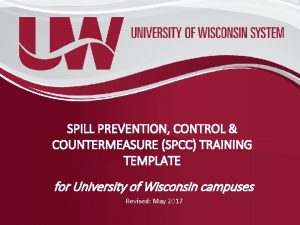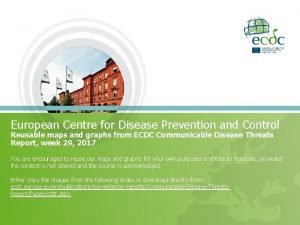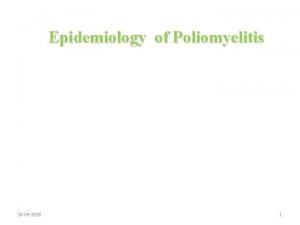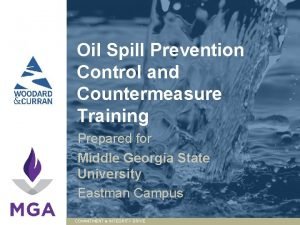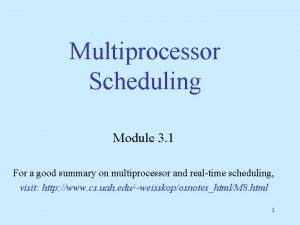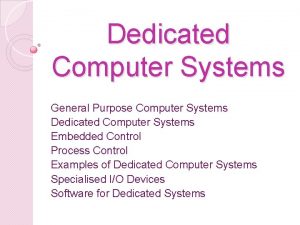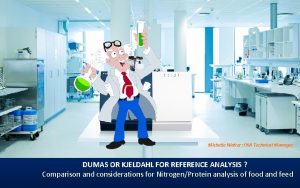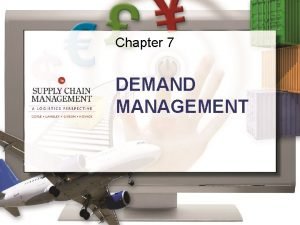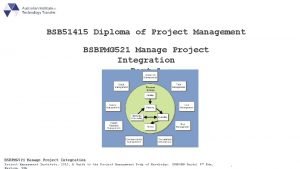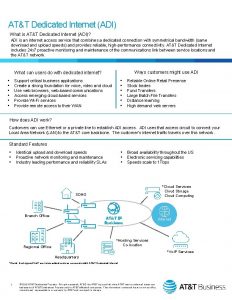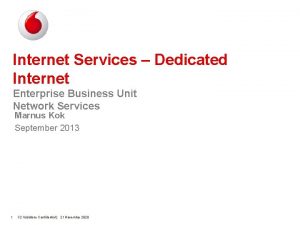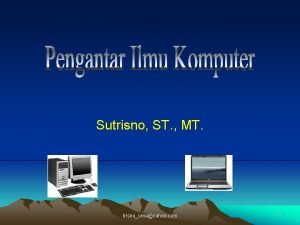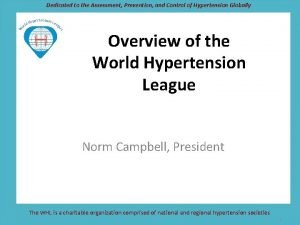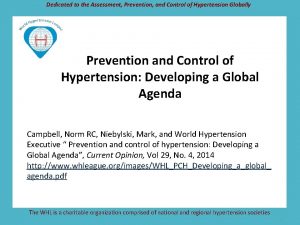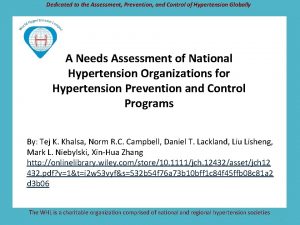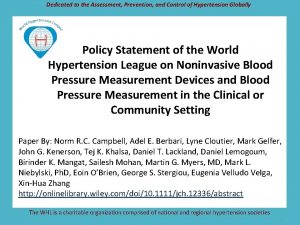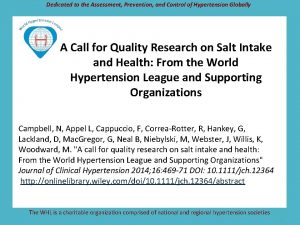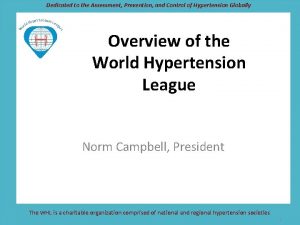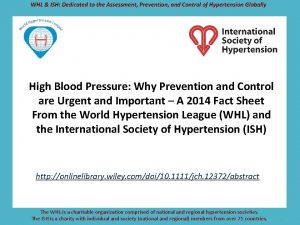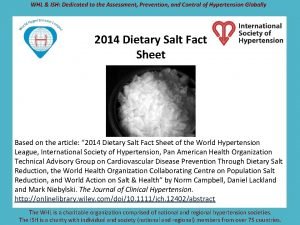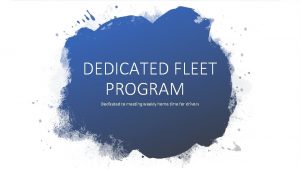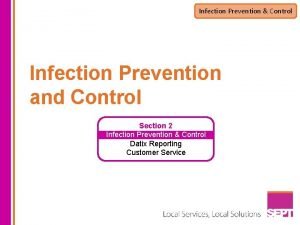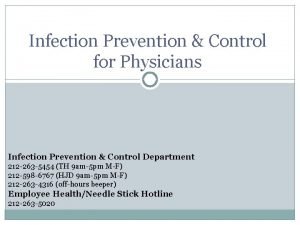Dedicated to the Assessment Prevention and Control of





















- Slides: 21

Dedicated to the Assessment, Prevention, and Control of Hypertension Globally Policy Statement of the World Hypertension League on Noninvasive Blood Pressure Measurement Devices and Blood Pressure Measurement in the Clinical or Community Setting Paper By: Norm R. C. Campbell, Adel E. Berbari, Lyne Cloutier, Mark Gelfer, John G. Kenerson, Tej K. Khalsa, Daniel T. Lackland, Daniel Lemogoum, Birinder K. Mangat, Sailesh Mohan, Martin G. Myers, MD, Mark L. Niebylski, Ph. D, Eoin O’Brien, George S. Stergiou, Eugenia Velludo Ve. Iga, Xin-Hua Zhang http: //onlinelibrary. wiley. com/doi/10. 1111/jch. 12336/abstract The WHL is a charitable organization comprised of national and regional hypertension societies 1

Dedicated to the Assessment, Prevention, and Control of Hypertension Globally The Journal of Clinical Hypertension • The Official Journal of the World Hypertension League offers free access which can be signed up for by: 1. Go to the Journal of Clinical Hypertension Homepage http: //onlinelibrary. wiley. com/journal/10. 1111/(ISSN)1751 -7176 2. Click on the down arrow next to the Log In/Register Option in the upper right corner of the screen 3. Choose the register option from the lower left corner of the dropdown box 4. On the log in page enter your e-mail address—which will become your user name –and select a password, enter your personal information (This information is not shared with outside parties), select promotional information you might like to receive and hit the submit registration button The WHL is a charitable organization comprised of national and regional hypertension societies 2

Dedicated to the Assessment, Prevention, and Control of Hypertension Globally Introduction • Increased blood pressure is the leading risk factor for death and disability globally. 1 • More than 40% of the adult population older than 25 years have hypertension. 2 • Most hypertension is preventable especially by reducing the amount of salt in food. 3 • Hypertension treatment can prevent the adverse consequences of stroke, heart attack, and heart and kidney failure. 3 • Unfortunately, about half of patients with hypertension remain undiagnosed. 4 The WHL is a charitable organization comprised of national and regional hypertension societies 3

Dedicated to the Assessment, Prevention, and Control of Hypertension Globally High Priority As a result of the increasing hypertension prevalence and its disease burden, WHL has made regular BP assessments and encouragement of widespread BP screening programs linked to diagnosis and clinical management of hypertension to be among the highest of priorities. The WHL is a charitable organization comprised of national and regional hypertension societies 4

Dedicated to the Assessment, Prevention, and Control of Hypertension Globally BP Assessment Recommendations Whether in low-, middle-, or high-resource settings, recommendations for BP assessment are consistent and include: 1. A standardized approach to pre-measurement preparation 2. Patient positioning 3. Appropriate cuff selection and placement 4. Measurement technique 5. Use of a validated automated BP-measuring devices 5 -10 The WHL is a charitable organization comprised of national and regional hypertension societies 5

Dedicated to the Assessment, Prevention, and Control of Hypertension Globally BP-Measuring Devices When selecting devices there is typically a choice between: • Manual devices using the ausculatory technique • Semi-automated (manual Inflation) devices using oscillometry • Fully automated (automated inflation) devices using oscillometry 9, 11 The WHL is a charitable organization comprised of national and regional hypertension societies 6

Dedicated to the Assessment, Prevention, and Control of Hypertension Globally Challenges with Manual BP Measurement While manual measurement using the ausculatatory technique has been the foundation of BP Measurement in the community for decades, there are many problems with it. • Despite numerous recommendations on how to perform manual BP measurement accurately, even with training, the recommendations are rarely followed outside of high-quality research trials. • Large bodies of evidence indicate that BP assessments are frequently inaccurate, with a high potential to misdiagnose a large segment of the population. 5, 12 -20 • Manual measurement of BP requires good hearing and extensive training in interpreting Korotkoff sounds. 5, 21, 22 • Even with training, the use of standardized manual techniques declines rapidly without regular retraining and accuracy testing. The WHL is a charitable organization comprised of national and regional hypertension societies 7

Dedicated to the Assessment, Prevention, and Control of Hypertension Globally Benefits of Semi-automated and Automated Devices • The use of automated devices requires much less training and has automated many features of the measurement. • During the past decade, there have been many advances in technology that have: 1. Reduced the cost of semi-automated and fully automated devices 2. Improved their accuracy 3. Allowed them to be used in settings where there is limited access to replacement batteries and limited electricity for recharging • Use of solar panels and cell phone chargers 5, 10, 23 -26 The WHL is a charitable organization comprised of national and regional hypertension societies 8

Dedicated to the Assessment, Prevention, and Control of Hypertension Globally Challenges of Semi-automated and Automated Devices • It can be difficult to select the proper cuff size. • Several other technical aspects still rely on the observer’s training and skill. • In many individuals the readings using automated devices produce readings that differ from readings with manual techniques. -In these settings it is unclear which method is a better reflection of arterial BP. The WHL is a charitable organization comprised of national and regional hypertension societies 9

Dedicated to the Assessment, Prevention, and Control of Hypertension Globally Challenges with All Methods of BP Measurement Regardless of the method used to measure BP, arrhythmias can cause BP to be highly variable and multiple readings are required in these patients to increase accuracy The WHL is a charitable organization comprised of national and regional hypertension societies 10

Dedicated to the Assessment, Prevention, and Control of Hypertension Globally Device Recommendations for BP Measurement • The World Health Organization (WHO) has recommended the use of validated semi-automated oscillometric devices in the STEPS survey http: //www. who. int/chp/steps/manual/en/ • A WHO expert committee also recommended these types of devices for clinics in low-resource settings “given serious inherent inaccuracy of the auscultatory technique”. 2, 5, 16, 26 The WHL is a charitable organization comprised of national and regional hypertension societies 11

Dedicated to the Assessment, Prevention, and Control of Hypertension Globally The Purpose of the Development of this Policy Statement This policy statement has been developed by the World Hypertension League in order to: 1. Stimulate health and scientific organizations to adopt the WHO recommendation for automated BP devices broadly, not only in low- but also in middle- and high-resource settings 2. Work towards the use of these devices for training healthcare professionals and the public 3. Advocate that all clinical settings have and use these devices for routine BP assessment 4. Better ensure that all communities have screening programs that use automated devices at a capacity to ensure that a majority of patients with hypertension are identified. The WHL is a charitable organization comprised of national and regional hypertension societies 12

Dedicated to the Assessment, Prevention, and Control of Hypertension Globally It is Key to Note: • When this policy statementions semi-automated and fully automated devices it refers only to devices that have passed international standards for accuracy and that use an upper arm cuff. • Devices that have not passed international accuracy standards and where the cuff is not positioned on the upper arm are not recommended for routine BP assessment and should not be used in the assessment of hypertension. 5, 27 The WHL is a charitable organization comprised of national and regional hypertension societies 13

Dedicated to the Assessment, Prevention, and Control of Hypertension Globally In Conclusion the WHL Recommends: • That in community screening settings for noninvasive BP assessment, a semi-automated or fully automated oscillometric BP device that uses a range of upper arm cuffs be used wherever feasible. • That in clinical settings for noninvasive BP assessment, a semiautomated or fully automated oscillometric BP device that uses a range of upper arm cuffs be used routinely and that manual BP measurement with a recently calibrated device, appropriate cuff size, and a recently trained observer be used to estimate BP only where automated measures are not feasible for technical reasons. • That where resources allow, consideration be given to incorporate self-/home BP measurement, fully automated office measurement devices that operate without a health care professional present, and ambulatory BP measurement in the diagnosis and management of hypertension. The WHL is a charitable organization comprised of national and regional hypertension societies 14

Dedicated to the Assessment, Prevention, and Control of Hypertension Globally WHL Recommendations Continued: • That training programs for healthcare professionals focus on the use of semi-automated or fully automated oscillometric BP devices that use a range of upper arm cuffs in conjunction with the importance of diagnosis and managing hypertension. • That systematic approaches are put in place in all clinical settings to have routine BP assessment at all clinical encounters. • That governmental and nongovernmental organizations work to ensure all communities around the globe have BP screening programs that use semi-automated or fully automated oscillometric BP devices and the programs have a capacity to ensure that the majority of population are screened and those with high readings are appropriately referred for diagnosis and management. The expectation is that people identified with high BP readings will be referred to clinical settings for evaluation. The WHL is a charitable organization comprised of national and regional hypertension societies 15

Dedicated to the Assessment, Prevention, and Control of Hypertension Globally WHL Recommendations Continued: • That in clinical settings, the manual method be retained as a backup to automated measurements with the understanding that BP readings are likely to be inaccurate in the absence of a wellcalibrated device, appropriate cuff size selection, regular training, and accuracy testing. • Although use of the manual/auscultatory technique is not endorsed as the standard, it is recommended that when clinical settings and screening programs require the use of manual devices then there should be appropriate resources for ongoing training and testing for accuracy. • That governments, health and scientific communities, and BP pressure device manufacturers work to ensure widespread availability of affordable validated automated BP devices and specifically include those that will operate in settings without a reliable electricity supply. The WHL is a charitable organization comprised of national and regional hypertension societies 16

Dedicated to the Assessment, Prevention, and Control of Hypertension Globally References 1. Lim SS, Vos T, Flaxman AD, et al. “A comparative risk assessment of burden of disease and injury attributable to 67 risk factors and risk factor clusters in 21 regions, 19902010: a systematic analysis for the Global Burden of Disease Study 2010”. Lancet. 2013; 380: 2224– 2260. 12. World Health Organization. “A Global Brief on Hypertension: Silent Killer, Global Public Health Crisis. World Health Day 2013”. Report, 1 -39. Geneva, Switzerland: World Health Organization; 2013. 3. World Health Organization. “A Global Brief on Hypertension: Silent Killer, Global Public Health Crisis. World Health Day 2013”. Report, 1 -39. Geneva, Switzerland: World Health Organization; 2013 4. Kearney PM, Whelton M, Reynolds K, et al. “Worldwide prevalence of hypertension: a systematic review”. J Hypertens. 2004; 22: 11– 19. 5. World Health Organization. “Affordable Technology: Blood Pressure Measuring Devices for Low Resource Setting”. Report, 1 -26. Geneva, Switzerland: World Health Organization; 2005. 6. Pickering TG, Hall JE, Appel LJ, et al. “Recommendations for blood pressure measurement in humans and experimental animals. Part 1: blood pressure measurement in humans. A statement for professionals from the Subcommittee of Professional and Public Education of the American Heart Association Council on High Blood Pressure Research”. Hypertension. 2005; 45: 142– 161. . The WHL is a charitable organization comprised of national and regional hypertension societies 17

Dedicated to the Assessment, Prevention, and Control of Hypertension Globally References 8. Padfield PL. “Measuring blood pressure: who and how? ” J Hypertens. 2009; 27: 216– 218. 8. Taylor J. “ 2013 ESH/ESC guidelines for the management of arterial hypertension”. Eur Heart J. 2013; 34: 2108– 2109. 9. James PA, Oparil S, Carter BL, et al. “ 2014 evidence-based guideline for the management of high blood pressure in adults: report from the panel members appointed to the Eighth Joint National Committee (JNC 8)”. JAMA. 2014; 311: 507– 520. 10. Padfield PL. “Reduction of cardiovascular morbidity and mortality in the third world: the importance of accurate blood pressure measurement”. Hypertension. 2010; 56: 1038 – 1039. 11. Daskalopoulou SS, Khan NA, Quinn RR, et al. “The 2012 Canadian hypertension education program recommendations for the management of hypertension: blood pressure measurement, diagnosis, assessment of risk, and therapy”. Can J Cardiol. 2012; 28: 270– 287 12. Mc. Kay DW, Campbell NRC, Parab LS, et al. “Clinical assessment of blood pressure”. J Hum Hypertens. 1990; 4: 639– 645. 13. Campbell NRC, Myers MG, Mc. Kay DW. “Is usual measurement of blood pressure meaningful? ” Blood Press Monit. 1999; 4: 71– 76. 14. Campbell NRC, Milkovich L, Burgess E, Mc. Kay DW. “Self-measurement of blood pressure: accuracy, patient preparation for readings, technique and equipment”. Blood Press Monit. 2001; 6: 133– 138 The WHL is a charitable organization comprised of national and regional hypertension societies 18

Dedicated to the Assessment, Prevention, and Control of Hypertension Globally References 15. Campbell NRC, Culleton BW, Mc. Kay DW. “Misclassification of blood pressure by usual measurement in ambulatory physician practices”. Am J Hypertens. 2005; 18: 1522– 1527. 16. O'Brien E. “Demise of the mercury sphygmomanometer and the dawning of a new era in blood pressure measurement”. Blood Press Monit. 2003; 8: 19– 21. 17. Rouse A, Marshall T. “The extent and implications of sphygmomanometer calibration error in primary care”. J Hum Hypertens. 2001; 15: 587– 591. 18. Yong PG, Geddes LA. “The effect of cuff pressure deflation rate on accuracy in indirect measurement of blood pressure with the auscultatory method”. J Clin Monit. 1987; 3: 155– 159. 19. de Greeff A, Lorde I, Wilton A, et al. “Calibration accuracy of hospital-based noninvasive blood pressure measuring devices”. J Hum Hypertens. 2010; 24: 58– 63. 20. Roubsanthisuk W, Wongsurin U, Saravich S, Buranakitjaroen P. “Blood pressure determination by traditionally trained personnel is less reliable and tends to underestimate the severity of moderate to severe hypertension”. Blood Press Monit. 2007; 12: 61– 68. 21. Campbell NRC, Mc. Kay DW, Chockalingam A, Fodor JG. “Errors in assessment of blood pressure: blood pressure measuring technique”. Can J Public Health. 1994; 85(suppl 2): S 18 –S 21. 22. Campbell NRC, Mc. Kay DW, Chockalingam A, Fodor JG. “Errors in assessment of blood pressure: patient factors”. Can J Public Health. 1994; 85(suppl 2): S 12–S 17 23. Sliwa K, Stewart S. A low-cost solar-powered blood-pressure device. Lancet. 2011; 378: 647– 648. The WHL is a charitable organization comprised of national and regional hypertension societies 19

Dedicated to the Assessment, Prevention, and Control of Hypertension Globally References 24. Parati G, Kilama MO, Faini A, et al. “A new solar-powered blood pressure measuring device for low-resource settings”. Hypertension. 2010; 56: 1047– 1053. 25. Parati G, Mendis S, Abegunde D, et al. “Recommendations for blood pressure measuring devices for office/clinic use in low resource settings”. Blood Press Monit. 2005; 10: 3– 10. 26. World Health Organization. “Automated Solar-Powered Blood Pressure Monitor”. Report, 1 -2. Geneva, Switzerland: World Health Organization; 2012 27. O'Brien E, Asmar R, Beilin L, et al. “Practice guidelines of the European Society of Hypertension for clinic, ambulatory and self blood pressure measurement”. J Hypertens. 2005; 23: 697– 701. The WHL is a charitable organization comprised of national and regional hypertension societies 20

Dedicated to the Assessment, Prevention, and Control of Hypertension Globally Based on the Paper: “Policy Statement of the World Hypertension League on Noninvasive Blood Pressure Measurement Devices and Blood Pressure Measurement in the Clinical or Community Setting” Norm R. C. Campbell, Adel E. Berbari, Lyne Cloutier, Mark Gelfer, John G. Kenerson, Tej K. Khalsa, Daniel T. Lackland, Daniel Lemogoum, Birinder K. Mangat, Sailesh Mohan, Martin G. Myers, MD, Mark L. Niebylski, Ph. D, Eoin O’Brien, George S. Stergiou, Eugenia Velludo Ve. Iga, Xin-Hua Zhang http: //onlinelibrary. wiley. com/doi/10. 1111/jch. 12336/abstract Power. Point Created By: Kimbree Redburn Power. Point Reviewed By: Norm Campbell The WHL is a charitable organization comprised of national and regional hypertension societies 21
 Primary prevention secondary prevention tertiary prevention
Primary prevention secondary prevention tertiary prevention Spill prevention control and countermeasure training ppt
Spill prevention control and countermeasure training ppt Dfpc jprs
Dfpc jprs Chapter 26 infectious disease prevention and control
Chapter 26 infectious disease prevention and control European centre for disease prevention and control
European centre for disease prevention and control Chapter 16 infection prevention and control
Chapter 16 infection prevention and control Prevention and control of poliomyelitis
Prevention and control of poliomyelitis Poliomyelitis slideshare
Poliomyelitis slideshare Spill prevention control & countermeasures training
Spill prevention control & countermeasures training Miss c.o. y r
Miss c.o. y r Romeo and juliet plot
Romeo and juliet plot Dedicated processor assignment
Dedicated processor assignment What is a general purpose computer system
What is a general purpose computer system Dumatec 8000
Dumatec 8000 Dedicated fulfillment
Dedicated fulfillment Bsb51415 assessment tool
Bsb51415 assessment tool Adi att
Adi att Saint vlassis dedicated team
Saint vlassis dedicated team Vodafone cloud server hosting
Vodafone cloud server hosting Wan technologies overview
Wan technologies overview Enterprise dedicated internet
Enterprise dedicated internet Contoh dedicated it system di atas kapal
Contoh dedicated it system di atas kapal

